It's kind of astonishing that people have managed to live in Iceland for over a millennium. Trees don't grow there — for hundreds of years they could only make boats of driftwood — let alone much else, so its natural cuisine is quite sparse and based mostly on eating things that can survive on what's around, namely sheep, fish, and whatever random birds can be scrounged up.

While there's plenty of influence from outside these days, the traditional Nordic month of Þorri (pronounced "thorri"), which starts in late January, emerged several decades ago as the time when Icelanders focus on the most distinctive — some would say grossest — parts of their cuisine in an assortment known as Þorramatur. I elected to forgo such options as rotten shark, fermented ram's testicles, and blood sausage, but I did make two dishes from sheep's heads. Apparently these sorts of food are eaten at this time of year because it's at this point when all the good stuff has ran out, and you're down to the odd parts and long-lasting stuff while waiting for spring.
Our adventurous guests for the night were Jessica, Elsa, Chrys, Kate, Dan, Raven, and Cassie.
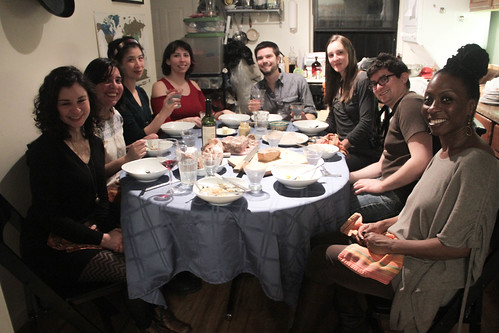
Áfengi | Drinks | Recipe for brennevín
We needed some liquid courage to steel ourselves for the adventures ahead. The traditional accompaniment to strongly flavored meats is brennevín, which means literally "burnt wine," or brandy, but is more precisely an aquavit. Not having found a local source for the stuff, I found a recipe and took matters into my own hands by infusing potato vodka with caraway seeds and a bit of sugar. After two weeks it turned a rich brown, and tasted quite a lot like taking a shot of a bold Jewish rye!
But then Dan and Raven turned up with a bottle of artisanal Icelandic brennevín that a friend of theirs brought when passing through Reykjavík. This one had about a quarter of the caraway pungency, but also the moderately bitter balancing from angelica seed. More complex and easier drinking, but I'm a bit partial to my punch-in-the-face version!
Iceland also marked the kickoff of Laura's project to come up with cocktails to match each meal. She went with the Midnight Sun, which is made with Icelandic lava-filtered vodka, hearkens to Iceland's traditional flavors with rhubarb, evokes the late-night summer glow with a haunting pale from violet liqueur, and makes it all tasty with blood orange liqueur and lemon. The drink was a hit, nicely balanced, so popular that we went through a whole vodka bottle's worth!
Midnight SunAdapted from Creative Culinary2 oz Reyka vodka1 oz Rothman & Winter Crème de Violette1 oz Solerno Blood Orange LiqueurHalf a lemon's juiceDash of Brooklyn Hemispherical rhubarb bitters
Sviðasulta | Sheep's head cheese | Recipe
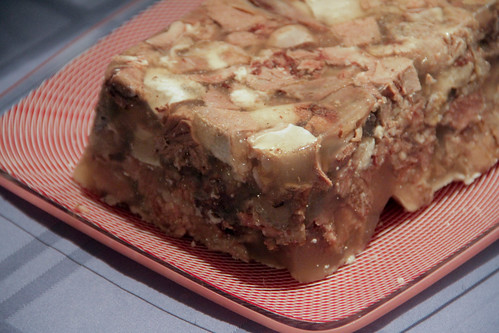
Well, I guess when you're trying to make use of every last bit of the lamb, this is what you do with the heads. (Which, I'll note, I got for the bargain price of $3 apiece, including slicing in half.) I removed the brains, singed the skin over an open flame, boiled the heads for about two hours, and picked off all the meat (which took quite a bit of effort, especially extracting the eyes). The chopped meat, plus some of the boiling water, set in the fridge overnight, and presto! You're the proud owner of a loaf of weird meat parts.
I have to say it tasted better than I expected, and the texture was no worse than I feared, but I can't say I'll be going through all the work to make this sort of thing again.
Rugbrauð | Steamed rye bread | Recipe
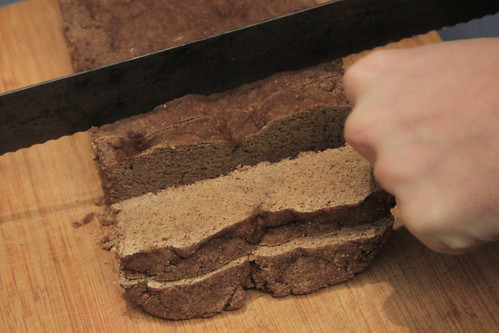
If you live in a land blessed with abundant geothermal energy, why would you bother to turn on an oven when you can instead steam your bread in a hot spring? Alas, I have no volcanic pools at my disposal in Brooklyn, so I used the next best thing: a crock pot. As you might expect, a steamed bread has zero crust and is pretty dense, but this sweet, moist, richly flavored loaf was a good balance to the head cheese, especially with a smear of butter!
Flatkaka | Rye flatbread | Recipe

These look and taste surprisingly similar to Indian chapati. The idea's basically the same: an unsweetened, unyeasted dough mixed with water, rolled out like tortillas, and toasted on high heat with no oil. These do have a smidge of baking powder which makes them a tad cracker-like when they come off the pan, but a sprinkling of water and a rest under a damp towel keeps them soft. (The recipe says to "dip in water," but I think that's a concept that might have been a bit lost in translation. Think anointing, not baptizing.) They bread is fairly bland but with that characteristic nuttiness of rye, and is a nice way to sop up some soup.
Kjötsúpa | Lamb soup | Recipe
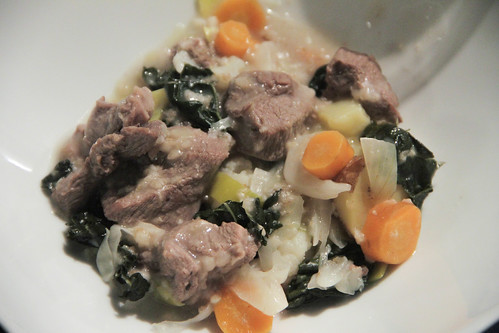
This was supposed to be a roast leg of lamb, but as I went to add a cup of liquid to the dish in the oven, I forgot the one inviolable rule of using glass bakeware: no sudden temperature changes. With a shattered casserole and shards of glass all over the oven, it was time to find inspiration in the Icelandic tradition of resourcefulness, and make do as I could. I slices off all the exposed surfaces of the leg lest there be any glass embedded, chopped the rest into pieces, and threw together what turned out to be a quite decent, if unexcitingly flavored, lamb stew. The texture was a bit interesting, with the novel addition of rolled oats to thicken it up and add some body.
Fiskibollur | Fishcakes | Recipe below

The waters around Iceland teem with fish, and the Icelandic culinary repertoire has figured out just about everything to do with it, from broiling to pickling to letting it dry on a stick in the wind and the sun for several weeks. But the recipe I saw most frequently was for balls or cakes, ground up and made into a batter, then fried. The most reasonable fish at the farmer's market was hake, which I passed through the meat grinder and made into a pasty mush with various liquids and starches. They took longer to fry up than I expected, but the result was quite nice, like a really fresh and tasty and fluffy version of Gorton's fishsticks
adapted from The Icelandic Cookbook by Hulta Emilsdóttir
2 pounds firm, white-fleshed fish fillets. I used hake; cod would be maybe even more appropriate. Pieces or scraps are OK. 1/2 small onion, chopped 1/8 teaspoon ground nutmeg 1/2 teaspoon pepper 2 teaspoons salt 2 eggs 1/2 cup milk (I ran out of milk, so I used a splash of cream plus some water) 1/4 cup flour 2 tablespoons cornstarch oil for frying (I used corn oil, plus some tallow that I rendered from extra fat from the lamb)
Start heating the frying oil. Put fish, onion, and spices in a food processor and grind, or for a fluffier texture do as I did and put through a meat grinder. Add eggs and milk, then flour and cornstarch, mixing with your hands. When the oil's good and hot (test with a little fleck of the fish batter), form into cakes (I essentially made a ball in my hands and flattened it a bit) and fry until golden brown on each side, maybe 15-20 minutes total.
Brúnaðar kartöflur | Caramelized potatoes | Recipe at end of post

adapted from The Icelandic Cookbook by Hulta Emilsdóttir
2 lbs potatoes. Best is small new potatoes; if they're medium or big, cut them up. 1 cup sugar 1 tablespoon water
Boil potatoes, drain, and put back into the warm pot. Put sugar in a frying pan big enough for all the potatoes (but don't add potatoes yet). Heat on high, and using a heat-resistant rubber spatula, stir constantly. It will seem like it's not doing anything, then cluster up into chunks and brown a bit, and then liquify. When it liquifies, remove from heat and carefully add a few drops of water at a time while constantly stirring. Don't add more than a few drops at a time, and don't forget to stir, otherwise it'll chunk up again. Put potatoes in, toss to coat, and keep warm until serving. If at any point the sugar re-hardens, just heat and stir.
Pönnukökur | Fluffy crêpes (or thin pancakes)
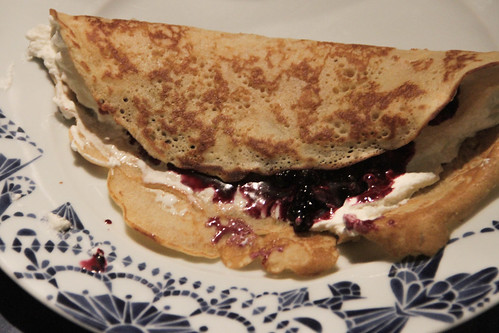
adapted from The Icelandic Cookbook by Hulta Emilsdóttir
3 tablespoons butter, plus more for frying pancakes 3 eggs, separated 3 cups flour 1/2 cup sugar 1/2 teaspoon baking powder 1/2 teaspoon baking soda 1 teaspoon vanilla extract 2-1/2 to 3 cups milk whipped cream jam (I simmered a bag of frozen blueberries with some sugar)
Melt butter in a crêpe pan (or a frying pan if that's all you've got) and let cool slightly. In the meanwhile, whip the egg whites. In a separate bowl, perhaps a 2-quart measuring cup with a spout, combine the dry ingredients, then add the butter and enough milk to make the batter fairly runny, like a crepe batter. As you reheat the pan, fold the egg whites into the batter. Once the pan is good and hot, pour about a quarter cup of batter into the pan, and swirl around to cover, pouring any excess back into the batter. Put whipped cream and jam inside of the pancake, fold up, and devour. Note that the pancakes can be successfully made in advance and reheated in the microwave before serving.
The playlist for the meal was surprisingly familiar. Betwen Björk, Sigur Rós, and Of Monsters and Men, this Virginia-sized island with a population smaller than Anaheim has made an outsized dent on the American music scene!
